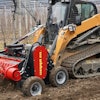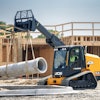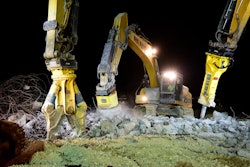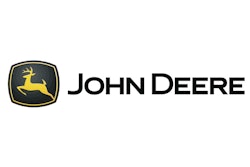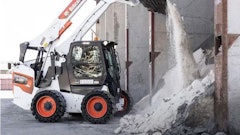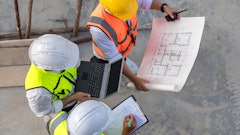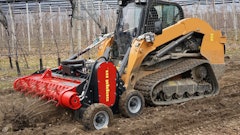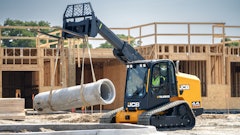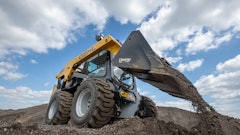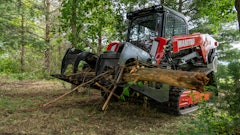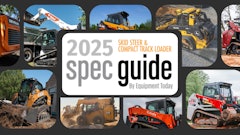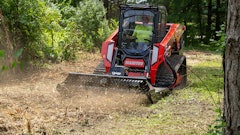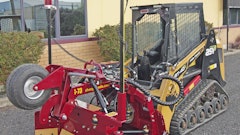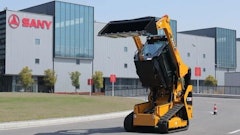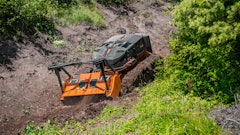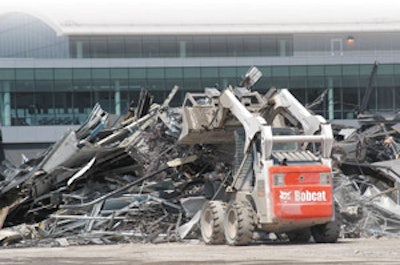
Broken concrete chunks, abrasive asphalt surfaces, exposed rebar, scrap metal and splintered wood are just a few of the hazards found on a demolition site that can render construction equipment lame or lifeless. While various machines are capable of working demolition, skid-steer loaders are often called upon to do a lot of the dirty work because their compact size and corresponding maneuverability make them a good choice for working in tight spaces. Their relatively small size (most contractors use small- to medium-size machines) also means they can be lifted and moved from floor to floor to take down buildings one level at a time.
Because a demolition environment is such a harsh place for equipment, there are certain factors you should consider when selecting, equipping and using a skid-steer loader in this application.
Choose the right attachment
For starters, select a machine that fits your job needs. "If the machine is lifting heavy loads, then a beefy vertical-lift machine may be more efficient," says Gregg Zupancic, John Deere Construction. "For working in really tight spaces, a smaller radial lift-style boom might work better."
Attachment selection and use also play a role in the longevity of the machine. Thanks to the availability of task-specific attachments that allow one skilled operator to replace several laborers, as well as high-flow hydraulics and hydraulic mounting plates that enable attachment changes without leaving the cab, switching between the most appropriate attachment for the job is a relatively easy task.
"Whether using a grapple bucket, shears or hammers, having the right combination of machine to attachment will make the difference between making a profit and losing money," says David Daniels, New Holland Construction.
In many cases, skid-steer loaders are called upon to break up concrete flatwork, foundations and block walls, adds Mike Fitzgerald, Bobcat Co. "Attachments such as a hydraulic breaker can cause stress on the skid-steer loader if it isn't operated properly," he points out. "It's important for operators to monitor the breaker's pressure and grease it to promote a longer life."
Protect your investment
When you set out to equip your machine, protect your investment by focusing on those areas most vulnerable to damage. At the top of the list is what's underneath your machine - its tires.
The estimated industry average for skid steer tread life ranges from 400 to 600 hours, depending on the application, operator skill and tire maintenance schedule, indicates Zupancic. "Abrasive surfaces, such as concrete and asphalt, and work areas with severe hazards, such as waste transfer, demolition and metal recycling, will result in faster worn tires," he says. "That's why it's important to choose the correct tire for your skid steer."
A traditional bias-ply tire is the most economical option from an initial investment standpoint, but its life can be most easily shortened in severe-service conditions. One tip for extending the life of a pneumatic tire is to run at the manufacturer's recommended air pressure and follow a recommended tire maintenance schedule, Zupancic suggests.
Many contractors choose to line bias tires with a protective gel (done during the manufacturing process) or to fill them with foam/polyurethane (aftermarket) to enhance survivability. Others use semi-pneumatic (also known as aperture) tires. And for extremely difficult conditions, you may want to consider solid tires. "These tires will stand up better in the harsh demolition jobsites," says Fitzgerald.
To provide further protection, some manufacturers, such as New Holland, offer valve stem guards to protect from damage. And special tire guards can be added to the machine to minimize punctures.
Guards are also available to protect other areas of the machine, including the engine, door, etc. Gehl offers a bumper/counterweight option that not only provides for more lift capacity, but also acts as a shield to protect the rear of the machine from damage.
Most manufacturers offer the option of demolition-style doors and reinforced top and rear windows to protect the operator from debris during demolition work. A three-point seat belt for the operator provides additional safety. Many equipment dealers can provide customized equipment protection packages based on the application, so discuss any special features you may need with your local dealer.
Clean and inspect your machines often
Machines that routinely work in a demolition environment will require more care to keep them in top operating condition. "A demolition environment is hard on the machine because of the nature of the work being done, the cycle time of the machine and the application conditions on the machine," says Kelly Moore, Gehl Co.
Daily maintenance tasks - such as checking fluids and filters - are similar to those you should perform for any piece of construction equipment, and they can be done quickly before starting the machine. In addition, look for any damage to hydraulic cylinders, lines, etc. Because of the severe service environment, check for possible structural cracks and wear to the machine to reduce the risk of premature failures.
Pay special attention to the tires and inspect them on a daily basis, as well. "Tires are turning hard and running over debris," says Moore. "Check that lug nuts are tight and that tires are wearing equally. If one tire is gouged or badly damaged, replace it as soon as possible. Running one tire in a lesser condition than another can cause strain on the machine and negatively affect steering, plus you will have more tension on some of the drivetrains. Whenever damage occurs, it's in your best interest to get it replaced as soon as possible."
Schedule service more frequently
Scheduled service tasks, such as oil and filter changes, etc., will likely need to be performed more frequently than for skid-steer loaders used in more traditional dirt-moving applications.
"Small particles can get into bushing and pin contact areas and can cause accelerated wear and damage, as well as expensive service bills," says Daniels. "That is why frequent regular greasing intervals are recommended. Plus, acceleration of accumulating debris in the radiator area can cause frequent overheating of the unit."
How much more frequently should you schedule these tasks? "Going above and beyond the recommendations can improve the life of the machine," says Zupancic. "And be sure to perform maintenance according to the requirements in the manual, even if accelerated."
"With demolition, the question of 'how often' is often a judgment call," adds Moore. "It could be as much as twice the normal service interval. It's based on the application, so it's critical to watch the hour meter closely. And keep accurate records as to when you check the hour meter for performing various maintenance tasks. Following every single maintenance point in the manual is all the more critical in demolition - regardless of brand or size of machine. Oils, filter, etc. tend to get dirtier faster because of the harsh application. The machine is going through more difficult usage."
In addition to ramping up maintenance, if you work in an extremely dusty environment, you may also want to consider additional features such as air precleaners, which can help extend some of those already frequent maintenance tasks. Air precleaners prescreen the air by filtering out large particles before they reach the air cleaner. This helps to protect the engine and components to extend their life, as well as the life of the machine.
The bottom line is to keep the machine in the best operating condition possible. "It's about minimizing downtime," says Moore. "Not doing regimented maintenance and complete servicing can lead to failures in the engine or with the machine. And when the machine is down, it would go without saying, you're losing money."


